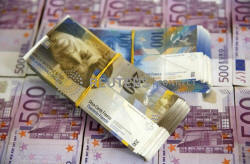Dollar, Swiss franc, yen in demand on China virus
uncertainty
 Send a link to a friend
Send a link to a friend
 [January 28, 2020] By
Saikat Chatterjee [January 28, 2020] By
Saikat Chatterjee
LONDON (Reuters) - Concerns about the
economic fallout from the coronavirus outbreak in China supported
safe-haven currencies on Tuesday, with the dollar index approaching a
two-month high and the Swiss franc holding near the highest in almost
three years.
Though global markets stabilised somewhat after Monday's selloff, there
was risk aversion in currency markets, with the Australian dollar
leading losers and the dollar strengthening to an 8-week high against
its rivals.
"Uncertainty on the virus news front is the name of the game in the
markets and markets don't like uncertainty," said Lee Hardman, a
currency strategist at MUFG in London.
The euro/Swiss franc cross <EURCHF=EBS>, a pair highly correlated to
risk sentiment, touched 1.0666 francs per euro, the lowest since April
2017, before recovering to 1.0690.
It has fallen 1.6% so far in January and is on track for its biggest
monthly drop since April 2019.

Global stock markets and oil prices have tumbled in recent days on fears
the virus could further damage China's already weakened economy, an
engine of world growth. That also briefly inverted the U.S. Treasury
yield curve, considered a fairly reliable recession predictor. [MKTS/GLOB]
[nL8N29X2KI]
But larger moves were subdued, with the U.S. dollar adding to previous
gains ahead of the start of a two-day U.S. Federal Reserve meeting later
on Tuesday.
Against a basket of currencies <.DXY>, the dollar rose 0.1% to 98.01,
its highest since early December and taking its gains so far this month
to 1.7%. It remains unfazed by signs that money markets are pricing a
U.S. Federal Reserve interest-rate cut later this year and possibly even
a second.
[to top of second column] |

A picture illustration of Swiss Franc and Euro banknotes taken in
central Bosnian town of Zenica, January 26, 2015. REUTERS/Dado Ruvic

Versus the euro, it firmed 0.14% to an eight-week high of $1.100 <EUR=EBS>
Fed policymakers are largely expected to reiterate that interest rates will
remain on hold this year. [nL4N29V03E]
"The market is taking a step back from the selloff earlier due to the virus
concerns though the dollar is unlikely to weaken substantially as there is
safe-haven demand for the greenback," said Morten Lund, a senior FX strategist
at Nordea.
The Australian and New Zealand dollars <AUD=D3><NZD=D3>, both highly geared to
China, shed 0.2% and 0.1% respectively.
Stability in the offshore yuan, after a recent drop, provided some calm to
nervous currency markets. The Chinese currency firmed 0.2% versus the dollar <CNH=D3>,
rising off three-week lows. At a time when mainland markets are shut, the
offshore yuan has weakened more than 2% in less than a week.
Elsewhere, the yen <JPY=EBS> held steady at 108.97 per dollar, close to its
strongest level since Jan. 8.
Japan's currency has risen against the greenback for the last five trading
sessions due to growing risk aversion.
The Norwegian crown was another laggard <NOK=D3>, weakening 0.3% versus the
dollar to six-week lows, dented by six days of falling oil prices.
(GRAPHIC: Swiss franc positions and Euro vs Franc -
https://fingfx.thomsonreuters.com/
gfx/mkt/13/1544/1519/EURCHF.png)
(Reporting by Saikat Chatterjee; Editing by Angus MacSwan, Kirsten Donovan and
Bernadette Baum)
[© 2020 Thomson Reuters. All rights
reserved.] Copyright 2020 Reuters. All rights reserved. This material may not be published,
broadcast, rewritten or redistributed.
Thompson Reuters is solely responsible for this content. |